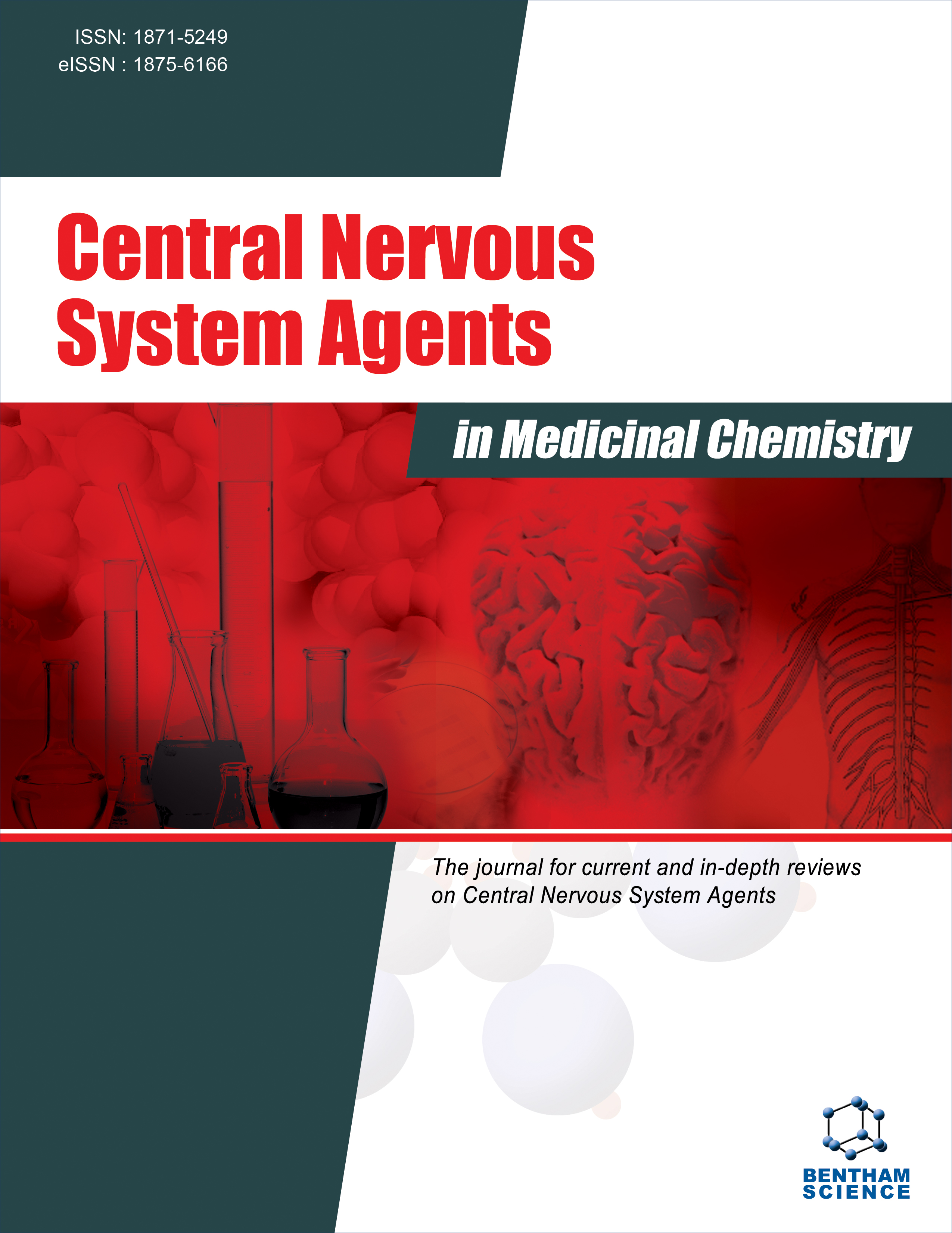- Home
- A-Z Publications
- Central Nervous System Agents in Medicinal Chemistry (Formerly Current Medicinal Chemistry - Central Nervous System Agents)
- Previous Issues
- Volume 9, Issue 4, 2009
Central Nervous System Agents in Medicinal Chemistry (Formerly Current Medicinal Chemistry - Central Nervous System Agents) - Volume 9, Issue 4, 2009
Volume 9, Issue 4, 2009
-
-
Brain Serotonin, Psychoactive Drugs, and Effects on Reproduction
More LessSerotonin, a biogenic amine, is present in significant amounts in many structures of the CNS. It is involved in regulation of a wide variety of physiological functions, such as sensory and motor functions, memory, mood, and secretion of hormones including reproductive hormones. It has also been implicated in the etiology of a range of psychiatric disorders such as anxiety, depression, and eating disorders, along with oth Read More
-
-
-
On Some Physiological Aspects of Ethanol Repercussion on Neural and Cardiorenal Functions
More LessChronic ethanol ingestion, mostly in young adults, constitutes a frequent drug-abuse situation, which is associated to a wide variety of pathological disturbance affecting a number of organs, including liver, kidney, heart, pancreas and brain. The ethanol effects are more prominent when occurring at the perinatal period of life, generating, among other disabilities, brain developmental and functional impairments, as well a Read More
-
-
-
Dual Cross-Talk between Nitric Oxide and D-Serine in Astrocytes and Neurons in the Brain
More LessAuthors: Elena Darra, Florian H. Ebner, Kazuo Shoji, Hisanori Suzuki and Sofia MariottoThe present review describes the role of the putative cross-talk between two neurotransmitters, nitric oxide (NO) and D-serine, in the brain. Under physiological conditions NO homeostasis guarantees the correct function of NO in a number of events in the brain such as neurotransmission and vascular tone regulation. D-serine, produced in astrocytes, acts synergistically with glutamate at NMDA receptors on postsynaptic neuro Read More
-
-
-
Anticonvulsant and Neurotoxicity Evaluation of Some N4 Phenyl Substituted Pyridyl Semicarbazones
More LessAuthors: Navneet Aggarwal, Pradeep Mishra, Badri P. Nagori, Ruchi Aggarwal and Jainendra JainA series of 4-aryl substituted semicarbazones of pyridyl carbaldehyde and pyridyl methyl ketone were designed and synthesized to meet the structural requirements essential for anticonvulsant activity. The structure of synthesized compounds were confirmed by IR spectroscopy, PMR spectroscopy and nitrogen estimation. All the compounds were evaluated for anticonvulsant activity and neurotoxicity. Anticonvulsant ac Read More
-
-
-
Efficacy of HGF Gene Transfer for Various Nervous Injuries and Disorders
More LessAuthors: Naoki Kato, Kuniaki Nakanishi and Koichi NemotoHepatocyte growth factor (HGF) was originally identified as a molecule that could stimulate DNA synthesis in rat and human hepatocytes by autophosphorylation of the proto-oncogene c-met, which is a high-affinity receptor for HGF. Although it was at first considered that HGF could exert biological effects only on specific target cells, it has since been demonstrated that HGF mediates inflammatory responses to tissue injury Read More
-
-
-
Are Circulating Monocytes as Microglia Orthologues Appropriate Biomarker Targets for Neuronal Diseases? (Supplementry Table)
More LessAuthors: Gerd Schmitz, Kerstin Leuthauser-Jaschinski and Evelyn OrsoMicroglial cells, in contrast to other central nervous system cell types such as neurons and macroglia, are of myeloid origin. They constitute the immune cells of the brain and are involved in neuroinflammatory and neurodegenerative processes. Moreover, diseases of the central nervous system with an inflammatory component are characterized by the migration of bone marrow-derived monocytes into the brain where t Read More
-
-
-
Hormones in the Mentally Disturbed Brain: Steroids and Peptides in the Development and Treatment of Psychopathology
More LessAuthors: George T. Taylor, Susan Maloney, Joshua Dearborn and Juergen WeissOne of the more fascinating recent discoveries in neuroscience is the widespread influence of hormones on brain regions and functions underlying pathological behaviors. A story is unfolding that points to critical roles played by hypothalamic - pituitary - gonadal (HPG) and hypothalamic - pituitary - adrenal (HPA) axes on a startling array of mental disorders, from depression to dementia. The influence of peptides and steroi Read More
-
Volumes & issues
-
Volume 25 (2025)
-
Volume 24 (2024)
-
Volume 23 (2023)
-
Volume 22 (2022)
-
Volume 21 (2021)
-
Volume 20 (2020)
-
Volume 19 (2019)
-
Volume 18 (2018)
-
Volume 17 (2017)
-
Volume 16 (2016)
-
Volume 15 (2015)
-
Volume 14 (2014)
-
Volume 13 (2013)
-
Volume 12 (2012)
-
Volume 11 (2011)
-
Volume 10 (2010)
-
Volume 9 (2009)
-
Volume 8 (2008)
-
Volume 7 (2007)
-
Volume 6 (2006)
Most Read This Month
Article
content/journals/cnsamc
Journal
10
5
false
en


